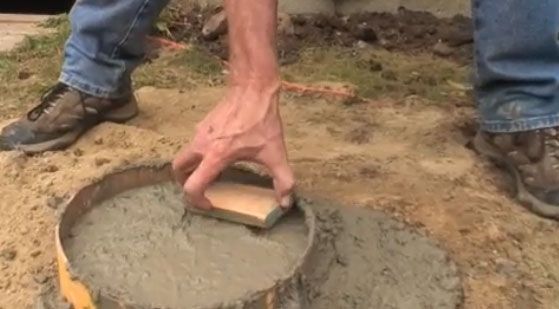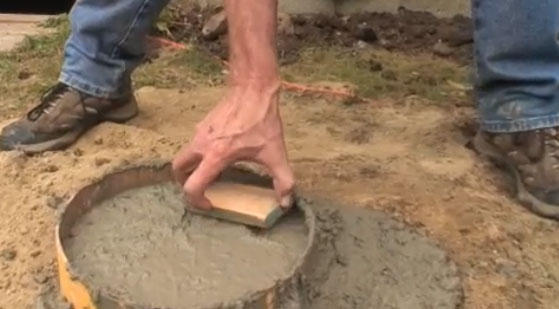How to Level Up Concrete Piers?

A poster calling himself NoTalent-AllThumbs has a problem. He was in a hurry when he poured 8-in. and 10-in. dia. footings for a deck, he explains in Breaktime’s Construction Techniques forum, and now the tops of the piers aren’t level. He wonders how he’s going to set 4×4 posts.
After mulling this over, NoTalent has come up with a couple of ideas. One approach, he says, would be to cut the tops of the 4x4s at an angle so deck beams would sit on them squarely. But the posts would be set out of plumb.
Option two is to level the tops of the piers by setting a new tube over each pier and pouring fresh concrete to form a level base for each post.
“Do you think that any of these options are feasible?” he asks. “Are there any other fixes that you would suggest or should I just bite the bullet and redig?”
Posts must be plumb
A horrified Axemann wonders whether the question is really a trick.
“Stop!” he warns. “Do not proceed with either option put forth in the question! Your posts must be plumb. Without plumbness of posts, deck will come down during first 100-person deck-hosted karaoke jam. Lawsuits would follow.”
Axemann suggests NoTalent cut the bottoms of the 4x4s to compensate for the pitch on top of the footings.
“If working alone, set an over-long post on top of a pier and hold it plumb with a quick clamp or two holding your level to the post,” he writes. “Measure with your tape to see how much your cut will need to be skewed to get maximum surface area in contact with the pier. Do this for all other posts and make the skewed cuts with a circular saw.”
In any case, NoTalent should provide a good mechanical connection between the post and the footing, even if the tops are perfectly level. As long as the tops of the piers “are not pitched like an Olympic ski mogul,” Axemann says, a Simpson Strong Tie connector or its equivalent should be fine.
“The post will bear fine even if it is a little out of jive with the base.”
If NoTalent is suggesting the piers themselves, and not just the tops, are out of plumb, well that’s a different story: “If they are four foot in the ground and do stick up 3,4, or ten feet and are wildly out of plumb you will probably have to start over.”
Or try some patching concrete
MarkH assumes the footings are plumb, just not level at the top, and that NoTalent will be using metal post connectors that bolt to the concrete. If that’s the case, he says, all you have to do is use patching concrete to level the pier tops. There shouldn’t be any adhesion problem with the patch.
DanH agrees. “If the tops of the piers are too unlevel for the brackets,” he says, “you can level them off with some sort of concrete patch. (I’d use thinset, but others here think I have a thinset obsession.)
“When you make a patch of this sort, if the surface isn’t rough enough to give a thick patch good “tooth” you can drill some holes and install concrete screws sticking out a bit, to give the patch something to bind to.”
Don’t overreact, adds Clewless1. You can cut a slight angle at the bottom of the posts, or shim the top of the pier with concrete to make a level surface.
Just make sure the posts are “perfectly plumb.”
Just grind it level
Adding patching concrete to the tops of the piers is one option. Another is to grind the concrete flat, as several posters suggested.
Assuming NoTalent has an extra inch or so of height, that’s how JTC1 would proceed:
“I would be inclined to grind the tops of your existing piers to level,” he says. “Keep in mind they do not have to be perfectly smooth. Any height issues can be easily dealt with by varying the post hieghts. A 7-in. (or even a 4-1/2-in.) diamond grinding cup would make pretty short work of this project with no potential bonding issues to deal with.
“Take some away rather than adding…”
Joe Carola agrees. “It’s a simple fix,” he says. “Just grind the footing level where the base will go and bolt it in. Cut your post square at the bottom and plumb it up.”
Keeping forming tubes straight
Keeping concrete forms plumb can be tough even for the most experienced contractor, writes George of Plumbatube. Which explains the company’s product, a reusable bracket that slides over the top of a form and is held in place with 2×4 braces. The tool, as George is happy to point out, not only keeps forms plumb, but also can be used to get exact on-center spacing from form to form.
It’s an advertisement, OK. But Calvin finds value in something that “could very possibly be useful to someone undertaking this type of job.”
“The original poster could have certainly used it,” he says.
FURTHER RESOURCES:
Introduction: Build a Grade-Level Deck – Watch veteran builder Mike Guertin as he builds a new, grade-level deck on the Fine Homebuilding Project House.
A Solid Deck Begins with Concrete Piers – Learn how to size, layout, dig, form, and pour concrete to build a simple but sturdy deck foundation.
Fine Homebuilding Recommended Products
Fine Homebuilding receives a commission for items purchased through links on this site, including Amazon Associates and other affiliate advertising programs.

Handy Heat Gun

8067 All-Weather Flashing Tape

Affordable IR Camera
























View Comments
I do'nt see what the problem is. Use 4x4 or 6x6 post connectors, level them with galv. washers underneath the connectors(different sizes have different thickneses), then use heavy duty grout(available at most masonry centers. Pack it in under the connectors, even if they are 1"off the concrete thats ok. Pack the grout in,mixed very dry!Very dry is the key, no slump,it should not run out from under. When it sets up you will be able to build plumb and carry all the weight you want.
I agree with chaz1 this is not much of an issue.
The real issue of ignorance is that someone self described as "No Talent - All Thumbs" decided to build a deck for himself instead of calling in a professional.
And we wonder where these stupid codes come from.
DC
ditto chaz1
Hi.
I have never posted before - don't like to give advice, but...
This situation, along with the height of the columns, is a common problem - especially when constructing large buildings. We pour non-shrinking grout into, cut to height (or in your case levelness), metal catch basin rings on top of the column and fill them in.
It still baffles me that the grout has a greater psi than the concrete.